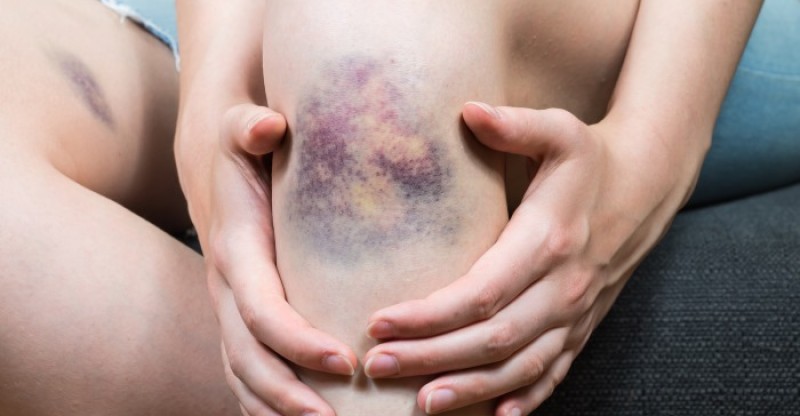30 Science-Backed Ways to Get Rid of Bruises Quickly
Bruises are a very common ailment, especially for kids and those of us who are less graceful.
They can be tender, painful, and they also aren’t very pretty to look at it.
Luckily, there are ways to help treat this issue at home to expedite the healing process and help you feel better, faster.
If you or your child bruise easily, we have some great information for you in this article on how to get rid of bruises quickly and effectively.
We’ve rounded up the best remedies we could find and examined them using scientific reasoning to discover which actually work so that you can feel better faster.
What are Bruises?
A bruise occurs when you bump into or are hit by something; the contusion to the area results in the discoloration of the skin.
Blood from damaged blood vessels leaks out and collects close to the surface of the skin.
The blood pools together, forming a discolored area that usually starts off as a black, blue, or purple hue (1).
Bruises can occur from a wide variety of events.
Some people who exercise vigorously, like weightlifters or athletes, get bruising as a result of microscopic tearing of the blood vessels under the skin.
Elderly individuals are more prone to bruising due to the thinning of the skin as we age (1).
Many times, we can get a bruise and not really remember where it came from since bumping into objects is such a common occurrence as we go about our daily lives.
The Two Main Types of Bruises
A flat, purple-hued bruise that occurs when blood leaks into the top layers of the skin are commonly referred to as an ecchymosis.
A hematoma is a larger mass of coagulated blood that has clotted and collected.
A hematoma differs from a simpler ecchymosis or contusion due to the area swelling, becoming raised, or being more painful.
Symptoms of a Bruise
After the initial injury, the skin may appear red.
As the blood travels closer to the surface of the skin, it will take on a dark blue or dark purple shade, usually within a few hours.
As the injury heals over the following days it transitions to yellow or green before eventually fading away.
The bruise may initially be very tender. As the color fades away, the pain does as well.
Some bruises hurt more than others.
The good news is that since the skin is not broken, there is little to no risk of infection.
On average, most bruises will fade away within two weeks and your body reabsorbs the blood that leaked out of the broken capillaries.
However, some can last for months, depending on the severity and amount of blood vessels that were damaged.
If it lasts longer for more than two weeks, you may need to see your health care provider (2).
How to Prevent Bruises
As soon as you bump into something, or you fall or suffer a hit, it’s imperative to put ice on the injury.
This will help to decrease the amount of blood that leaks from the broken capillaries.
It will also help with swelling, pain, and inflammation (3).
Cover the ice pack with a towel so that your skin doesn’t get too cold.
You can leave it on safely for ten-minute increments. You can repeat this process several times a day.
You can also elevate the injury above your heart.
This will aid in reducing swelling while limiting the amount of blood that pools, which can help lessen the chance of bruising (3).
Wearing proper sports equipment can be helpful.
If you play soccer, shin guards can aid against bruising from accidental kicks.
Ensuring that coffee tables and other furniture are spaced properly to allow plenty of walking room can also be helpful.
And you can keep a flashlight handy to make nighttime bathroom trips safer (5).
Potential Problems from Bruising
Sometimes a bruise will start to become firmer, and may even increase in size, as opposed to lessening and fading away.
It can also continue to increase in terms of pain intensity.
In some cases, this more severe version of a hematoma could possibly need to be drained by a physician (2).
More rarely, the body may deposit calcium in the afflicted area.
Calcium is the same material within the human body that comprises most bone.
When this happens, the injured area will become very tender and firm.
This condition is commonly referred to as traumatic myositis ossificans.
This issue usually occurs after a single blow to an area, a muscle is torn, or with repeated minor trauma to an area.
The afflicted portion of the body eventually develops a mass with a consistency similar to cartilage, like the kind found in your ears and nose.
This most commonly happens with injuries sustained in the thighs, biceps, or the pectoralis major muscles, and will require a diagnosis and treatment from your health care provider (24).
In some cases, a bruise can be indicative of a more serious issue, like a bleeding disorder.
If you are constantly finding yourself bruised or bleeding easily, it’s definitely worth a visit to your doctor to check for any health issues (1).
Just like with any injury, bruises can range in size and severity.
Some are worse than others and may be worthy of a trip to your healthcare provider.
When to Seek Medical Care from Your Physician
Sometimes a contusion or bruise can become a more serious condition.
If you are experiencing bruising accompanied by extreme pain and swelling, you should call your doctor.
This is especially true for individuals on certain medications.
If you take any blood thinning prescriptions, such as coumadin or warfarin, you should speak with your healthcare provider (1).
If the bruise has appeared for no real reason, you should also speak with your doctor.
This could indicate a serious health condition.
And it is important to be seen for bruises that are under a toenail or fingernail that are painful.
If the bruise does not begin to improve after two weeks or has failed to clear completely within three to four weeks, you should make an appointment with your physician.
If you are concerned that you have a broken bone along with the bruise, you should head to the nearest emergency room or urgent care clinic.
This is important so that you can receive proper treatment to ensure any breaks heal properly (3).
Bruising on the head or near the eyes can cause a lot of worry and anxiety.
If you get a bruise or “goose egg” on your head, but do not blackout, it is unlikely that you have sustained a serious head injury.
Likewise, if you remember the event that caused the injury.
However, if you did pass out or don’t remember the details surrounding the injury, you should seek treatment from your doctor, or head to the emergency room to rule out a concussion (3).
If you receive a bruise above your eye, you can usually expect for the bruise to travel to the skin underneath your eye as well.
This can create a black eye, due to the effects of gravity.
If you are unable to move your affected eye in any direction or have any changes in your vision, you should make a trip to the emergency room (1).
If you do see a physician, they may order an X-ray for the area if they suspect there is a broken bone.
If the bruising occurs without any real reason, blood tests may be performed to check for bleeding disorders such as hemophilia.
Bruising can also be indicative of a domestic abuse situation if a person is constantly showing a pattern of bruising and injuries they are unable to explain (3).
Home Remedies for Bruises
We’ve rounded up the best ways to how to get rid of bruises.
We wanted to find how to remove a bruise, how to make bruises go away, and the fastest way to get rid of a bruise.
These remedies are very helpful in getting you feeling better, faster.
Ice Ice Baby
When looking for the fastest way to get rid of a bruise, this tried and true remedy is our number one for good reason.
The application of ice can cool down the broken vessels and capillaries while helping to slow down and stop the leaking of blood.
This means that the bruise will be smaller.
Apply an ice pack, covered in a towel, to the affected area for ten minutes.
However, you should not leave the ice on for more than 20 minutes, since it can damage your skin and blood vessels (4).
Bring on the Bromelain
Bromelain is an enzyme mixture that can be found in pineapples.
Pineapple has been utilized for centuries in both Central and South America to treat inflammation.
Bromelain is taken from the stem and juice of the pineapple and has been approved by the German Commission E to treat swelling and inflammation, both hallmark symptoms of bruising.
Unless you are keen on eating a ton of pineapple, you can take a Bromelain supplement of 500 mg up to four times a day to help get rid of the bruise faster (6).
Be a Wrap Star
Elastic bandage wraps are an excellent tool in helping to promote healing of a bruise while stopping it from spreading further.
Once you get a bruise, wrap an elastic bandage around the area as soon as possible.
This can help to control the blood leakage while aiding in the reduction of inflammation through the use of compression (7).
Let Things Get a Little Heated
Cooling compresses are the best course of action when you first sustain an injury.
But after the first 24 hours, you can begin alternating ice and heat.
The application of heat helps blood circulation to the area to aid in clearing away the pooled blood (4).
There are many great ways to apply heat to your bruise to help it heal.
You can use an electric heating pad for 20 minutes, several times daily.
Use caution, though, and put the heating pad on top of and not under the affected limb or area, to prevent burns.
You can also apply a warm compress to the area, or try using a hot water bottle.
Microwavable heat packs can also be handy to keep around in case of a bruise (4).
Peter Piper Prepared a Paste of Pepper
Cayenne pepper has a substance in it called capsaicin.
This element has incredible pain-relieving properties.
You can mix cayenne pepper with an ointment like Vaseline, and then apply the mixture to your bruise.
This can help reduce the pain and help it heal faster (10).
Take Your Vitamin K
Vitamin K is renowned for its effectiveness in the treatment of blood clotting and tissue damage.
You can take a supplement with vitamin K, or you can add plenty of dark green veggies to your diet.
Try broccoli, kale, or brussels sprouts (11).
These superfoods are beneficial for the proper maintenance of healthy red blood cells.
Ensuring you get enough in your diet can help bruises to heal fast, and keep your circulatory system functioning properly.
Grapes are Great
Grape seed oil is an excellent topical to aid in healing.
The antioxidants and flavonoids in this powerful oil can help heal you faster.
It also aids in increasing circulation. The oil is also wonderful for moisturizing your skin.
If you don’t want to use the oil, you can also eat regular grapes.
They have many excellent health benefits and make a healthy and beneficial snack choice (13).
Sugar, Sugar, Ooooh Honey, Honey!
Honey has amazing properties for health. It is antibacterial and promotes wound healing.
You can apply honey over the area of bruising, and cover with gauze or a bandage.
Honey is also great to swipe onto a minor cut to seal out any germs (14).
For best results, try using manuka honey or the raw, unprocessed kind you can find at local health stores.
Chocolate Makes Everything Better
Chocolate is derived from cocoa.
Cocoa has been utilized for centuries for its bioactive compounds.
These compounds have anti-inflammatory properties that can be extremely beneficial to the health of your skin.
You can make a paste of water and ground cocoa, then apply it to the skin that is bruised.
After it dries, you can top it with a bandage or some gauze to keep it in place for several hours.
Then just wash it off with soap and water.
You can also fight the effects of aging with cocoa paste by giving yourself a facial with it (15).
Time for Turmeric
Turmeric has been used for so long that it has 53 separate names in Sanskrit describing its healing abilities.
It has been proven effective as an antiseptic, an anti-inflammatory, and can even help individuals with gastrointestinal problems.
Turmeric is often used as a way to promote healing for bumps, scrapes, bruises, and contusions.
Turmeric paste is a great aid in helping your skin heal after an injury (16).
You can also add it to many different recipes to allow it to help you heal from the inside out.
It’s pretty yummy, too.
Tamarind Too
This super plant has a multitude of superpowers.
Tamarind has analgesic, anti-inflammatory, antiseptic, anti-microbial, and antioxidant properties, just to name a few.
Tamarind can be used in a paste on the bruised skin to aid in the reduction of swelling and pain and to promote the circulation of fresh blood to clear out the old blood from the bruise.
Much like Turmeric, it can also be ingested for a plethora of health benefits (17).
Awesome Arnica
Arnica is one of my favorite home remedies for bruises because it is effective and fast.
In a recent research study, patients saw bruising symptoms fade after surgery at a faster rate than those who did not use arnica (18).
Arnica can be applied topically over bruises or ingested as a supplement.
It aids in reducing pain and swelling and helping the unsightly blue and purple shades fade away more quickly.
Onions aren’t Just for Eating
Onions are known for being delicious, but they also have other interesting uses as well.
They are known for their anti-inflammatory benefits, and their ability to help in repairing damaged skin tissue.
You can slice an onion and place the slices on the affected area (19).
You may want to skip this tip though if you have an important meeting or a date planned.
The smell of onions can be extremely off-putting to some people.
Making a Case for Castor Oil
Castor oil has been used in medicine for many years.
New moms use it for diaper rash since it is an excellent moisturizer and promotes circulation.
It’s also helpful when applied to the bruised skin.
It will keep the outer layers of skin soft while reducing swelling and pain.
This remedy is also helpful in alleviating the dry, itchy feeling skin often gets during the healing process (20).
When Life Gives You Lemons
Lemons contain plenty of vitamin C which, as we mentioned earlier, is a great tool in fighting bruising.
You can use lemon juice on the injured skin by soaking a cotton ball in the lemon juice and then rubbing it in gently.
This remedy aids in decreasing swelling and speeding up the healing process.
Allow the juice to sit on your skin for five minutes, then rinse with cool water.
Skip this tip if you have a scrape or open wound, though, as lemon juice will sting.
You Say Po-ta-to I Say Po-tah-to
A raw potato compress is great for helping to reduce swelling from bruises.
This remedy works thanks to the alkaline juices of the potato.
The alkalinity causes it to have an antiseptic effect.
Just grate up some raw potato and place it on your skin. Cover it with some gauze or a bandage.
You can wrap plastic cling wrap over the bandage in order to receive the full effect of this trick (22).
Potatoes are also great to eat since they contain high levels of potassium, which is essential in the development of healthy skin tissue.
Planning Ahead with Lemon Balm Leaves
This is another of our favorite ways of how to remove a bruise, and it is wonderful to make ahead of time and keep in your refrigerator until you need it.
You’ll need a handful of lemon balm leaves.
Place them in a bowl, and cover them with 250 ml of almond oil. Allow the mixture to soak for two weeks, stirring it well each day.
After two weeks, strain the leaves out and add some vitamin E oil.
This is easier if you purchase vitamin E capsules, and puncture them with a needle or safety pin, then squirt the oil in (also great for applying directly onto your skin).
You can use it as an oil, or you can melt 25 grams of coconut oil or beeswax into your mixture and stir carefully to incorporate all of the elements.
You can keep it in the fridge until you need it, and then apply it directly onto your bruise (23).
Tea for Two
Herbal tea has many wonderful benefits for the body, and an herbal tea compress is a perfect way to treat contusions.
To make an herbal tea compress, add six drops of essential oil to eight ounces of water.
You can use any oil that you fancy, but we like lavender, eucalyptus, peppermint, or ginger.
Next, steep a bag of your favorite herbal tea (try chamomile) in the mixture.
Dip an unbleached muslin cloth, a washcloth, or some gauze into the solution and then apply over the injured area.
This compress can be used warm or cool.
You can try different oils and teas based on the effects you want.
For example, lavender is terrific before bedtime, since it has a calming, relaxing effect.
We love this method of how to make bruises go away since it is quick, easy, and personalized just for your needs (25).
All for Aloe
The leaves of the aloe vera plant produce a soothing gel that has been used for centuries in the treating of wounds and burns.
Aloe vera has demonstrated effectiveness in decreasing itching, burning, and scarring when applied to an injury.
This miracle gel can accelerate the healing of many skin problems such as frostbite, surgical scars, and common bruising.
Aloe vera aids the body in increasing dermal perfusion and acts as an analgesic and anti-inflammatory.
It has also been shown to have antibacterial and antifungal properties.
Aloe vera gel can be gently rubbed into the affected skin several times daily to help speed healing (9).
Praying for Healing with St. John’s Wort
St. John’s wort can be used in topical formulations such as oily extracts or ointments.
This remedy can be used in a wide range of ways including for bruising, superficial wounds, burns, and contusions (26).
You can find St John’s wort in oil form at most health food stores.
Rub it into the affected skin gently, several times daily.
It is wonderful for tense muscles, inflammation, and pain.
You can also soak a piece of unbleached muslin or gauze in the St John’s wort oil and apply it to the bruised area (27).
The multitude of uses makes this a favorite remedy to keep on hand.
Coffee Makes the World Go Round
Caffeine has many benefits for health, in addition to giving you energy and focus.
When ingested or applied topically, caffeine helps to increase the circulation of blood to the skin.
This can aid in the decrease of swelling, and help fresh blood remove the clotted blood, allowing the bruise to fade faster.
If you aren’t a coffee drinker, you can apply coffee grounds to the skin by making a paste.
Try mixing the grounds with a little coconut oil.
Then apply the mixture to the skin and cover with gauze or a bandage.
Leave it on the skin for an hour, then wash it away with water (28).
Get More Comfortable with Comfrey
You can also create a warm compress with comfrey.
Comfrey is chock full of compounds that aid the body in the reduction of swelling and the promotion of new cell growth.
You can make an herbal compress easily by steeping dried or fresh comfrey leaves in hot water for ten minutes.
Strain the leaves out and soak a washcloth or gauze pad in the solution, and apply it to the afflicted area for up to an hour.
Don’t drink the solution, though. It is only meant for topical use (8).
Be a Bit Sour with Vinegar
Vinegar can be mixed with warm water and applied as a compress, as well.
Vinegar helps to increase the flow of blood near the surface of the skin.
This can help to fade the bruise faster. Witch hazel can also be used similarly (9).
When using this remedy, take care to ensure that the water isn’t too warm.
It should be comfortable to have on the skin, without scalding.
Sunshiny Vitamin C
Vitamin C is another heavy hitter for health.
It aids in fighting off infection and improving the body’s natural immunity while encouraging healthy tissue development.
You can take a supplement or eat vitamin C-rich foods like mangoes, oranges, and sweet potatoes (12).
Vitamin C, also known as ascorbic acid, plays a vital role in wound healing and the development of new skin tissue.
It is found in many high-end skin creams and treatments.
In addition to ingesting plenty of vitamin C, you can purchase it in topical form at health food stores.
You can apply it over the bruised area several times each day to help heal the bruise.
Get Relief with Ginger
Ginger is excellent in helping skin heal from contusions and bruises.
This superfood contains powerful antioxidants that have many great benefits for the skin.
Slice some fresh ginger and apply it to the bruised area.
Rub it gently on the skin.
You can also increase your intake of ginger by eating it or taking a ginger supplement (29).
Get Golden with Marigold
Marigold has been used since ancient times as a healing herb for many issues.
It has been approved by the German regulatory authority Commission E for use as an antiseptic, and for wound healing.
Topical preparations containing marigold are excellent in treating conditions including wounds, burns, boils, varicose veins, rashes, and chapped skin, in addition to helping heal bruises.
It’s also great for diaper rash and mild forms of skin inflammation.
You can make an ointment by using 2 to 5 grams of marigold flower heads with 100 grams of ointment like Vaseline (9).
A Mediterranean Cure
Olive oil is a great moisturizer for the skin.
You can soak macerating mullein flowers in the oil to create an amazing topical oil that works wonderfully on the inflammation and pain of bruising while keeping skin moisturized and supple (30).
Berry Good for Bruises
Bilberry, which is similar to a blueberry, is an excellent fruit to use for bruising.
Bilberry works by increasing the strength of the blood vessel walls within the circulatory system.
With this strengthening, you can prevent bruising, or experience it on a smaller scale.
These healing berries contain a flavonoid called anthocyanin which provides the body with antioxidants.
Antioxidants remove free radicals and keep you in overall better health.
You can get the benefits of bilberry by either eating the fruit or taking it as a supplement.
Peas Please
If you don’t have an ice pack or even ice handy, try frozen veggies.
A bag of frozen peas or corn is great because the small frosty bead-like pieces can mold around the injury (1).
You can also refreeze it to use again as a compress.
Just don’t eat them if you have refrozen them, as it could breed germs.
A good rule of thumb is to label them as being for ice pack purposes, so you don’t mistakenly eat them and get sick.
We Like to Spoon
You can also throw a couple of spoons into the freezer to use as well.
This is also a great trick for swollen eyes (5).
Make sure you give them at least fifteen to twenty minutes to chill, then gently hold the cold spoon on the bruised area for ten minutes, or until it stops feeling cool.
You can put multiple spoons into swap out as they warm up.
The Do’s and Don’ts of Caring for a Bruise
- Do’s
You can use many of these remedies simultaneously, multiple times each day.
Remember only to apply cooling compresses for the first 24 to 48 hours after the initial injury.
After that time, you can alternate warm and cold treatments.
If the bruise isn’t too painful, you can also gently massage the area to increase circulation, improving the blood flow to the area.
This can help the old, clotted blood forming the bruise to dissipate faster.
It’s always a great idea to keep ice packs or frozen peas or corn in the freezer on the off chance you get a bruise.
That way, you have a cold pack ready to go at all times.
You may want to label the frozen peas or corn as an ice pack, so you don’t accidentally eat them and get sick.
Warm compress packs can be purchased at many big box stores or drugstores and kept for just-in-case moments as well.
Try to keep the bruised area elevated if possible to encourage healing, and use gravity to keep the blood from pooling.
- Don’ts
Never leave a cold or warm compress on too long.
When left for more than 25 minutes, the risk for skin damage increases exponentially (1).
Never place a heating pad under your arm, leg, back, etc.
Lying on it can cause serious damage and even skin burns.
If the injury is extremely painful or swollen, it’s usually worth a trip to the doctor to make sure you are all right.
Conclusion
In closing, bruising is an extremely common injury, especially for kids and those of us that are clumsier.
While most bruises will heal and fade away after two weeks, they can sometimes be more serious, warranting a visit to your physician.
There is a vast array of home remedies meant to treat and heal bruises quickly.
Many of the remedies we shared with you can be used for other issues as well, making them extremely useful to keep on hand.
We hope you enjoyed these health hints, tricks, and tips.
Be sure to leave us a comment sharing any of the remedies you’ve had success with, or tell us about your favorite bruise healing tips.
FDA Compliance
The information on this website has not been evaluated by the Food & Drug Administration or any other medical body. We do not aim to diagnose, treat, cure or prevent any illness or disease. Information is shared for educational purposes only. You must consult your doctor before acting on any content on this website, especially if you are pregnant, nursing, taking medication, or have a medical condition.
HOW WOULD YOU RATE THIS ARTICLE?






